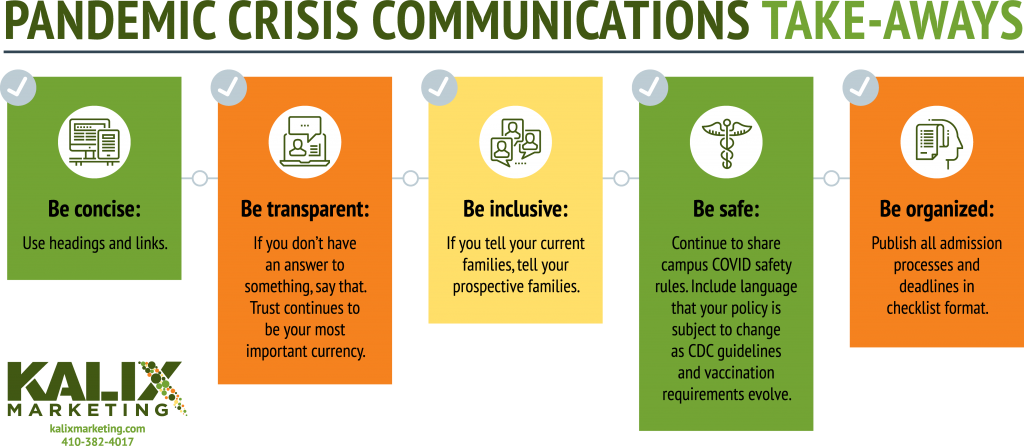Enrollment management offices at independent schools around the country are planning for a return to more traditional admissions programming for fall 2021. It’s a welcome relief from the challenges of marketing your school and engaging visitors during a global pandemic.
For every school and enrollment management office that changed its process in 2020 and 2021 – and changed it again, and then again – the return this fall to a more familiar process brings excitement and relief. It also brings an opportunity to rethink your marketing strategy.
There are great take-aways from pandemic admissions that every school needs to examine. To create your most strategic and resilient enrollment management marketing plan, ask yourself these three questions:
What worked well, didn’t work well and what pandemic programming should continue?
Dive deep into what you did for admissions programming, events and programming and enrollment management outreach and processes since the start of the pandemic. Many of the necessary pivots to virtual or hybrid programming and processes shouldn’t be discarded now.
Every school approached it’s pandemic admissions differently, but every school will find things that were unexpectedly good and effective and should be part of its outreach moving forward.
Use the data and a series of questions to drill down:
- What were your attendance numbers for every virtual event?
- How does this compare with in-person events if you did them last fall and this spring? With in-person events pre-pandemic?
- What events required an outdoor shift that were effective and can continue in that format?
- What creative programming did you put in place out of necessity that should continue?
- Did your pandemic programming include a first-ever focus on specific interests like sports, the arts or STEM? What was the reaction?
- What creative elements did you offer during the pandemic? Virtual shadow days? Mailing STEM kits to prospective students with a small-group Zoom session with a lower school science teacher to put them together? What were the results/reactions?
- Great way to gather more data: Consider phone or email surveys to those families who are newly enrolled who experienced your pandemic admissions programming. Gather anecdotal data on what they thought was effective and should (and should not) continue.
If, in a non-pandemic situation, you have five in-person fall information events, why not make one or two Zoom evening events? If last year, you had 15 families to an in-person, social-distanced event but had 70 register for an online program – and nearly all stayed through the hour-long program — that was a successful program.
Keeping some virtual events is convenient for your prospective audiences and your internal community (faculty, staff and current parent, student and alumni ambassadors who volunteer at these events). Families will appreciate the option to participate from home, in the evening, without the hassle of travel or finding a babysitter. And everyone is comfortable with Zoom by this point. If you put the recording of the session as on-demand content on your admissions page, you’ve offered yet another prospect-centered resource.
As schools open back up, there may be COVID-related safety restrictions. If your dining hall is not opening for safety reasons this fall, carefully explain to potential visiting families how that will affect shadow days. Is there another way to show potential visitors the excitement of your school community? What about an information session before an athletic event with an invitation to stay for the game, complete with a bag of snacks and spirit gear? It’s a great way for prospective families to get a feel for your community in an outdoor event.
What communication lessons from the pandemic need to continue?
Schools communicated differently and more frequently during the pandemic with current and prospective families. We had to. So much was changing constantly. Transparency in messaging equaled authenticity. It still does.
Every crisis communication lesson learned since March 2020 holds true for this fall:
Continue to be flexible with families and meet them where they are. Are you requiring shadow days in person? Or will you allow for a virtual equivalent if the family is not comfortable yet with in-person? Providing hybrid options is a human-focused approach and speaks to your school’s mission.
Communicating with faculty before classes start this fall is critical. The reality is that incoming classes this fall – at every grade level – were admitted with less information than in years past. The students’ previous school may have shifted to pass/fail grades for its remote-learning program. Parents and students may not have had access to online grades. Standardized testing may have been canceled.
You and your enrollment management staff worked hard to fill in gaps about a student’s abilities but, depending upon how much your faculty are involved in the admission process, they may not understand that. Talk to faculty about the enrollment information challenges and be ready to explain why you choose students.
How are you marketing your value-adds?
There are thousands of stories this past year of families who were in public schools who switched to independent schools because they wanted their child to learn in-person during the pandemic. In-person learning or hybrid programs were one of the biggest “value-adds” of independent school education – and the one that truly mattered to families in the last year.
Now is the time to double-down on sharing your school’s value-adds, especially to an audience who may have had a challenging experience at public school, many of which only came back in-person in late spring 2020.
Use words and imagery to showcase how your faculty and students handled it and highlight their successes. Share creative, engaging projects and learning – complete with photos of kids in masks and practicing social distancing.
If your school found safe ways to return to traditional programming and events, such as a championship sports season this past spring, show video of cheering crowds at the game. We have all missed being with each other. If your school has been able to embrace community during the pandemic, show it.
What are your other points of distinction now compared to public education? What are the emotions that stem from those distinctions?
College counseling was a real differentiator for independent schools during the pandemic. While visiting and applying to colleges was challenging for every senior during COVID, college counseling offices at independent schools were, for the most part, having the kind of personal connection between student and counselor that public schools could not during this time.
This distinction is very easy to draw now and should be further defined for your audience. Perhaps do a video of your college counseling team talking about how they focused on students during COVID and how it reaffirmed your school’s approach to preparing students for the next step.
Now, more than ever, it’s easier to remind your audience why families are choosing independent schools. Showcasing the heartstring emotions, especially following the unprecedented time we are living through, is the strategic marketing decision – and the one that will resonate with your audiences.
How is your school managing post-COVID enrollment? We’d love to hear about it or see how we can help. Schedule a time to speak with Jonathan Oleisky, President of Kalix Marketing.


